Types of industrial automation in the Smart Factory
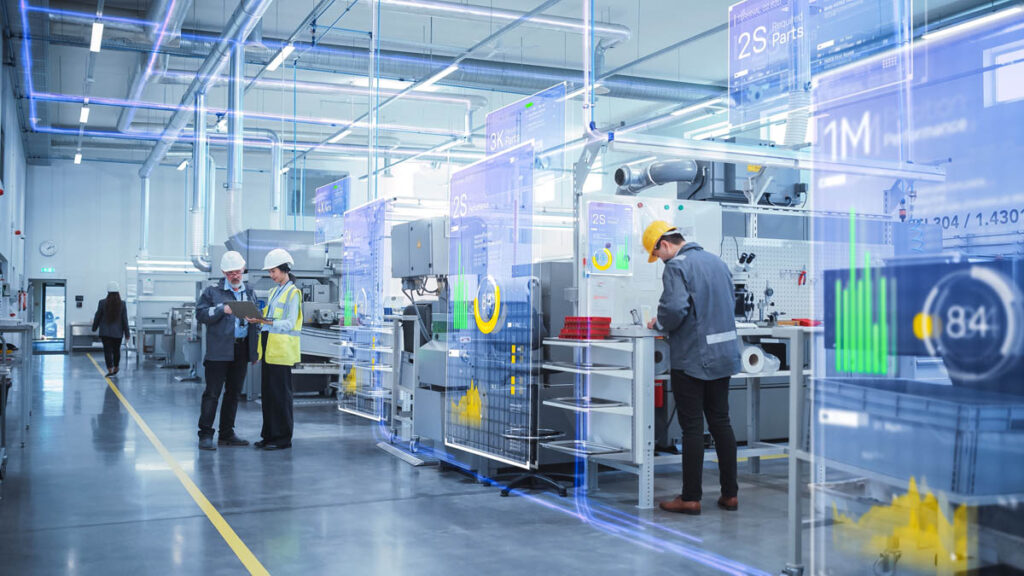
The evolution towards the Smart Factory must incorporate different types of industrial automation to enable companies that make up Industry 4.0 to improve processes, reduce costs and increase efficiency. Explore with aggity the types of industrial automation crucial for a successful Smart Factory. The Industrial automation is one of the essential components of the Industry 4.0. The so-called Smart Factory is employing an increasing number of technologies aimed at streamline processes, to improve efficiency and obtain a cost reduction. The use of control systems, the use of industrial sensors or the use of different machines for industrial robotics are just a few of the elements being used in smart factories, and all of this for several purposes: to improve production cycles, process quality and to achieve a more efficient production process. automated supply chain. In industrial automation, however, different typologies come into play: they are not all the same and are not all used for the same purposes. Each Smart Factory uses different types depending on the sector in which it operates or the product line it works. Therefore, in the transition to the Smart Factory, it is important to choose the most suitable industrial automation technologies for the business. These are some of these technologies: Fixed or rigid automation This is a type of automation in which the automated machinery is designed to perform a specific task that is repetitive. In this case, it is difficult for these machines to perform any other task as they are highly specialized to operate in a specific environment and context. An example of this is an assembly line. The opposite case is flexible automation, where there can be reconfiguration of systems to perform different tasks and adjust to different situations. Programmable automation In this case we are talking about systems, equipment or robots that can be reprogrammed to perform different tasks. This type of automation is common in batch production, where tasks can change regularly, allowing for improved production efficiency. Another common example is a Computer Numerical Control (CNC) system, used in the manufacturing industry, which allows the production of high-precision parts without human intervention. Adaptive automation Similar to flexible automation, in this case automated systems are able to adapt and adjust in real time to changing environmental conditions. To do so, they often use advanced technologies such as Artificial Intelligence (AI) or Machine Learning to autonomously make decisions and carry out process optimization according to environmental conditions. Robotic automation Employed in a wide range of industries, from manufacturing processes to production lines to logistics, industrial robots are used to improve efficiency and productivity by performing repetitive and monotonous tasks quickly and accurately. In addition, these robots can work in environments that are dangerous or difficult for humans, which helps to improve plant safety. Process control automation Incorporating production process control automation can bring a host of benefits, from reduced resource use to improved product quality. Its objective is to ensure optimal operation of industrial processes, while minimizing human error, maximizing efficiency, and improving the product quality. It is mainly used in the chemical and petrochemical industries. Warehouse automation As its name suggests, it is a technology that optimizes and speeds up storage and distribution operations in logistics centers. distribution in logistics centers. . This type of automation includes automated storage, conveying, sorting or management systems. These are just some of the types of industrial automation in the Smart Factory, although there are many more. Despite all this, it is important to have a partner like aggity, an expert in helping Industry 4.0 companies implement a well-defined automation strategy. A solution such as Smart Factory by aggity comprehensively covers the management and control of production, quality, materials and maintenance activities.
Avoiding losses in industry with AI and Machine Learning
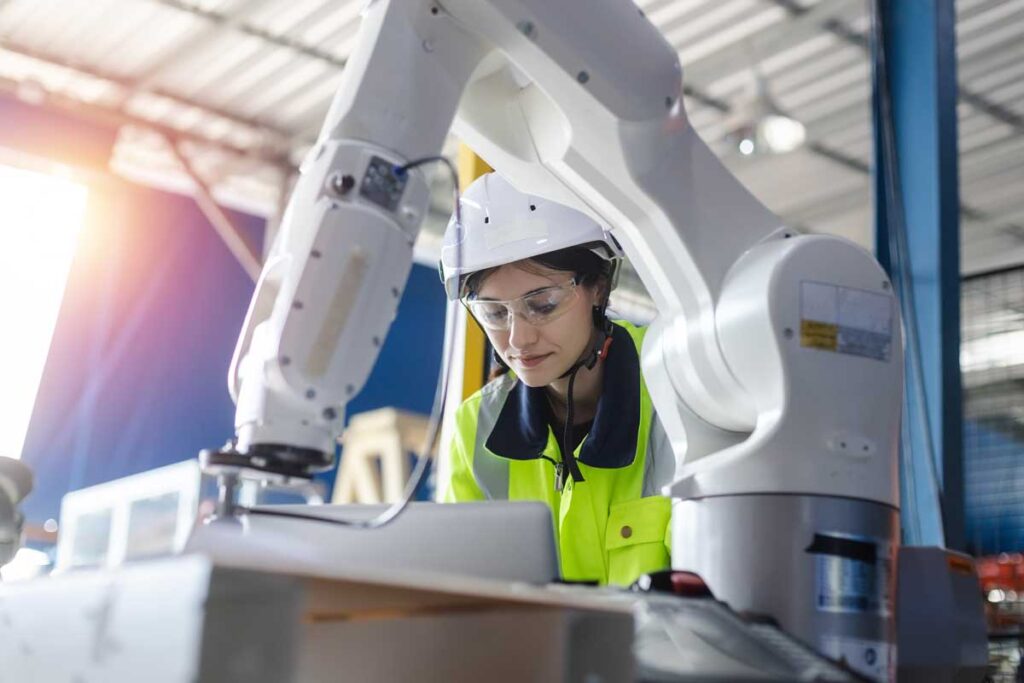
The use of artificial intelligence (AI) in industry will transform the companies that make up this sector in several areas, including inventory and stock management, where this technology promises to be a real revolution. The use of artificial intelligence in industry is of essential importance in supply chain management. One of the traditional challenges facing any organization in the industrial sector is inventory management. The transition to Industry 4.0 with the use of automation tools aims to put an end to these problems, but there is one element that can make perfect stock management possible: artificial intelligence. Far from the stardom of technologies such as ChatGPT, the truth is that the use of AI and Machine Learning in industry is contributing directly to the drive for Industry 4.0. The basis for the effective application of both technologies lies in the data. The big advantage is that machine learning in the industry enables AI to develop and make decisions quickly based on the analysis of large amounts of data. With all this information, artificial intelligence allows to identify patterns that allow to predict the demand to be produced, so that it is possible to adjust stock levels and thus avoid product shortages or overstocking, which in turn reduces losses associated with unsold or expired products. The use of artificial intelligence in Industry 4.0 and, in the future, in Industry 5.0, has already been in use for some time. Solutions such as Opera MES with aggity already cover a large part of the needs of today’s smart factory, offering a complete, modern, configurable and modular industrial management system that perfectly covers the management and control of Production, Quality, Materials and Maintenance activities. Supply chain management The use of artificial intelligence in industry is of essential importance in supply chain management. This is due to its ability to analyze data in real time, so that companies can identify and address problems that may arise. In this way, delivery delays are reduced, product quality is improved or production can be adjusted to take into account fluctuations in the price of raw materials. With this, the smart factory can make decisions to reduce the risk of losses. With the use of AI in the industry, inventory management is optimized by implementing machine learning algorithms that are able to automatically adjust stock levels based on demand and market conditions. These algorithms can continuously analyze sales data, consumer behavior and other relevant factors to optimize inventory levels. The value is in the data Despite the prominence of AI and Machine Learning in the development of Industry 4.0, these two technologies are meaningless if there is no data on which they can work. Data is the food that both technologies need, so it is necessary to collect it from different sources. The difficulty is that today there are many companies in the industrial sector that have not even begun to store data and many others do not have a strategy to collect and manage it efficiently, so they lose a large amount of vital information for business development. More advantages of AI in industry Once the data is well managed and analyzed, artificial intelligence and machine learning provide a number of other advantages such as the optimization of transportation and distribution routes as they are able to decide which are the best routes, improving efficiency and reducing costs. Likewise, loss and theft can also be prevented as Artificial Intelligence can detect suspicious patterns of activity in inventory and transportation.
Collaborative robots in industry 5.0
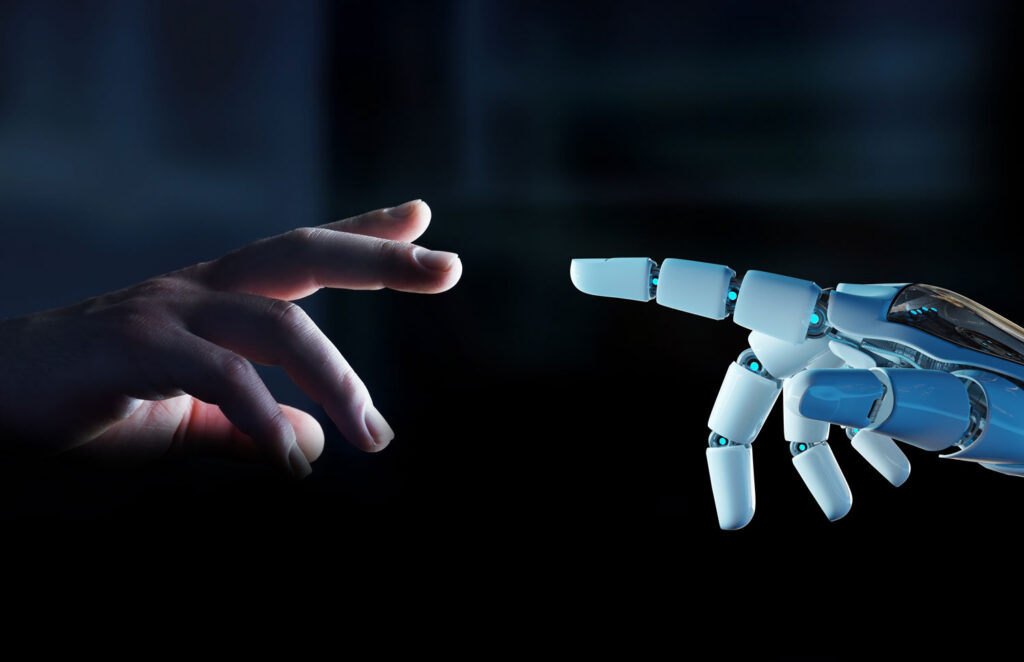
When industrial organizations are still immersed in applying and extending the processes of the so-called Industry 4.0, some companies are already taking steps in the next evolution which is Industry 5.0, where collaborative robots are going to play a prominent role. Collaborative robots are capable of doing any type of manual or repetitive work, but above all they are being used to reduce risks to workers. The difference between Industry 4.0 and Industry 5.0 lies precisely in the human factor. Industry 4.0 involves the digital transformation of traditional tasks with the implementation of techniques to improve production and that, in general involves the incorporation of technologies such as robotics, analytics, automation solutions and also the IoT or Internet of Things. Industry 5.0 continues to employ all of these technologies, but it is all about bridging the relationship that occurs between machines and humans. To this end, Artificial Intelligence is going to play a key role with the intention that cobots or collaborative robots perform processes that execute the thinking of a person. What is a collaborative robot Robots are one of the keys to Industry 5.0. In this case, when we refer to a cobot, we are talking about a robot that has been designed to work together with humans. In other words, unlike traditional industrial robots, cobots interact with humans and assist them in different tasks and processes. In other words, the cobot cannot function if there is no person at its side and vice versa. This is a perfect collaborative model. Collaborative robots are capable of doing any type of manual or repetitive work, but above all they are being used to reduce the risks that workers in industrial environments may suffer, thus reducing the possibility that they may suffer an accident at work. But if there is a differentiating aspect in the use of this type of robots in Industry 5.0 , it is to meet one of the main objectives of this new industrial revolution: to make organizations more human and attractive to workers. The role of the collaborative robot In an Industry 5.0 and smart factory environment, the aim is for humans to benefit from the possibilities and advantages offered by collaborative robots, such as their technical precision or their ability to lift very heavy material. On the other hand, workers can dedicate themselves to more complex tasks, giving industrial companies a greater degree of control and the ability to individualize each phase of production. Through the use of a collaborative robot, an organization can have greater potential for customization which, unlike automated Industry 4.0 systems, will enable greater job creation. The use of cobots in industry will radically transform industrial environments. Whereas up to now they have worked independently, in an Industry 5.0 environment, robots and humans work in unison. We will no longer see those spaces in which, even in the same physical space or on the same production line, you could see the robot on one side and the person on the other, working independently. Collaborative human-robot working together With Industry 5.0, that demarcation becomes more blurred as humans and robots begin to work together, such that the cobot will perform lower-value work and humans will provide the skills that the collaborative robot is incapable of performing. Solutions such as Smart Factory by aggity already allow to digitize the factory thanks to a perfect and complete automation of processes and prediction of actions and, soon, collaborative robots will improve all these processes. Industry 5.0 will enable more sustainable development and drive the creation of much more customized products tailored to individual needs. Sectors such as healthcare or the pharmaceutical industry will benefit significantly from this collaboration between humans and collaborative robots.
The work of the future in the smart factory
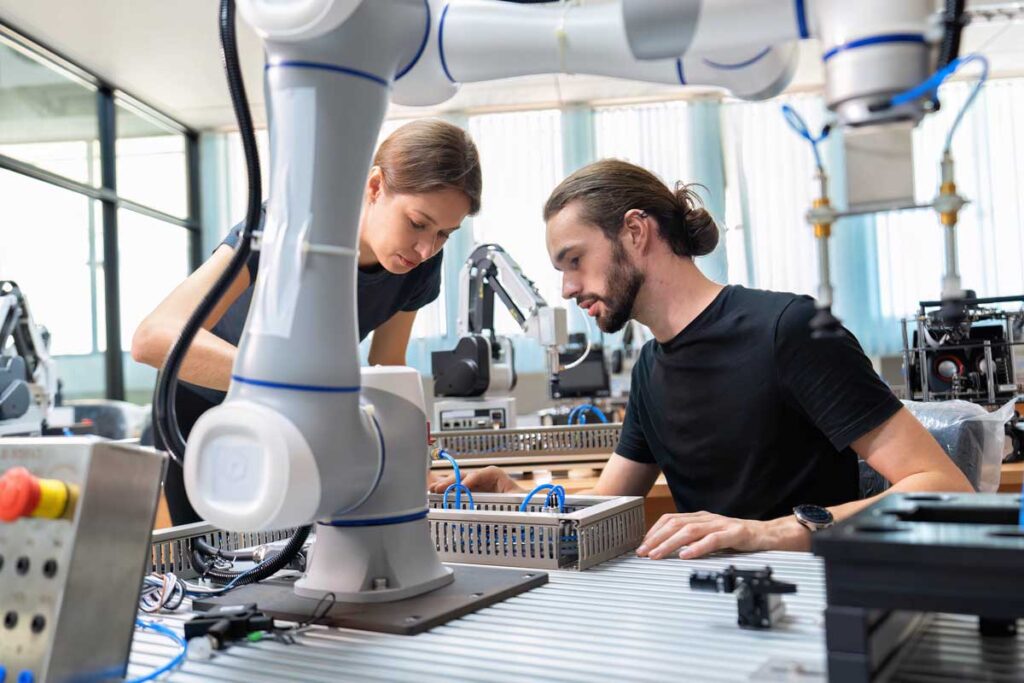
The work of the future in the smart factory will necessarily involve collaboration between machines and human workers. Numerous projects are already in place to facilitate such cooperation. Many of the projects to move towards the smart factory involve the incorporation of virtual reality. It is not known for certain what all the jobs that will appear in the future will be. What is known is that, especially in smart factory and Industry 4.0 environments, the relationship between humans and machines is going to be greater. For this reason, different projects are being carried out with the aim of developing technologies that facilitate the creation of collaborative environments between machines and humans. In general, in today’s industrial environments, machines and robots operate separately from employees, and that is what the smart factory is aiming to change. In the same way that, after the outbreak of the pandemic, collaborative work among employees was encouraged, with the incorporation of different tools, the work of the future in the smart factory is to create collaborative environments for workers and machines to work together in order to maximize the work done by both. The work of the future will be collaborative In short, the smart factory must be collaborative in all aspects and the technology must help on multiple fronts, not only in terms of intelligent product manufacturing. In this sense, technologies such as automation, virtual and augmented reality, adaptive interfaces, artificial intelligence and conversational chatbots are already being incorporated into smart factories and are making it possible for the work of the future to be more productive and collaborative. Many of the projects to advance in smart factories 4.0 involve the incorporation of virtual reality. In this case, this technology helps in immersive training actions that make the worker believe that he/she is in a real environment. Something similar to pilots’ flight simulators, only in this case the virtual reality mimics the manual control of machining in a factory with the movements of the tool. The employee interacts thanks to mixed reality in such a way that he/she feels as if he/she is touching a real element. Examples of smart factories The innovations that are taking place are manifold. For example, natural language processing is enabling workers in a smart factory to directly engage in conversation with the robot to ask questions about a particular maintenance operation taking place in the factory and teach it how to resolve the situation. And it is with mixed reality that a good part of the developments in the smart factory are taking place, especially in the assembly sections. In this case, a worker schedules the actions to be performed by a robot before it starts working on the task. Thanks to this mixed reality, it will be able to know if the robot’s performance will be correct and if so, the employee will give the order by voice for the robot to perform the job. Tools such as those proposed in aggity ‘s catalog for Industry 4.0 are already making it possible to advance the work of the future in the smart factory. By employing new technologies such as data analytics or Artificial Intelligence, these types of solutions enhance collaboration between machines and workers, increase factory efficiency, planning capacity and product quality, and also provide the organization with better techniques to protect against cyber-attacks. Advantages for machines and humans The incorporation of all these types of solutions to move towards the smart factory will have a long way to go in the coming years. Its benefits will not only mean an increase in productivity for companies in the industrial sectorThe employees will be able to carry out their work more efficiently, which will translate into a improving workers’ well-being and quality of lifeThe worker will be forced to adapt to the technology, but the worker himself will be the one who will advance in his learning with the help of the machine.
Smart factory and resilient infrastructures
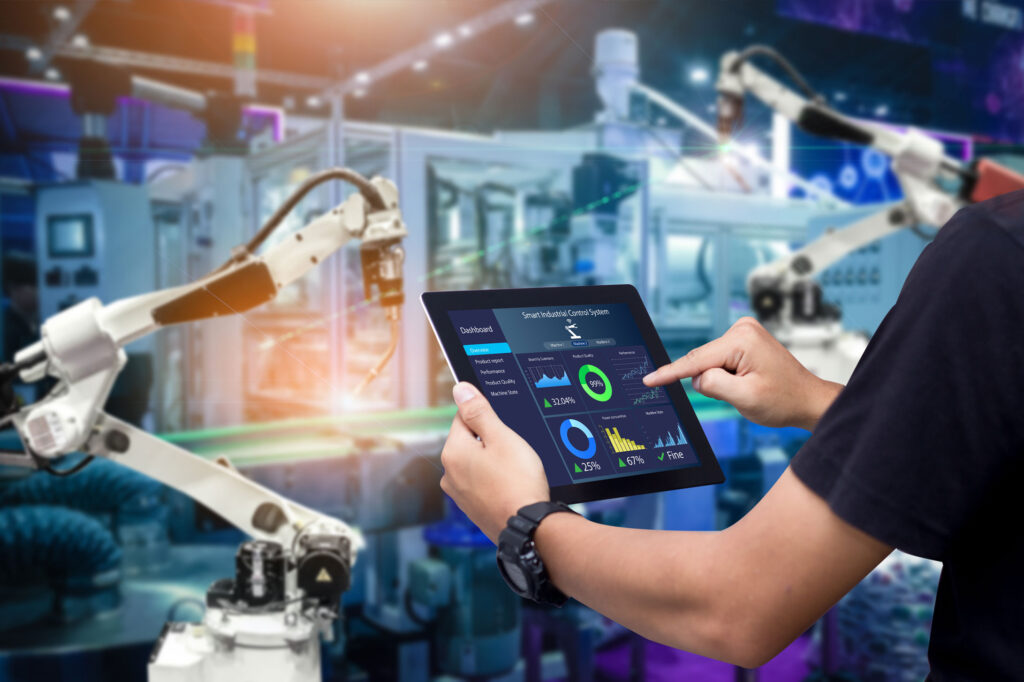
Goal 9 of the SDGs, «Industry, Innovation and Infrastructure», refers to the need to make factories resilient and sustainable infrastructures. The 2030 Agenda stresses the importance of developing the Smart Factory in order to build a resilient infrastructure. To achieve resilient and sustainable infrastructures, the UN emphasizes the modernization and conversion of industries into Smart Factories. Among the different points that appear in the set of Sustainable Development Goals (SDGs), there is one, number 9, which refers to the transformation of industry. The goal of achieving a more sustainable industry necessarily involves developing the so-called Smart Factory and building resilient infrastructures to meet the challenges facing the planet and humanity. It was 2015 when the UN presented the SDGs, whose goals include the intention to end poverty, protect the planet and ensure that the 2030 Agenda is met, so that when that year arrives all people can enjoy peace and prosperity in a better environmental setting. The goals of the 2030 Agenda are summarized in 17 points, but in this post we will focus precisely on that one, Goal 9, which seeks to achieve sustainable and inclusive industrialization. The intention of SDG 9 is to achieve resilient and sustainable infrastructures and, therefore, the UN emphasizes the need to modernize and reconvert industries by making a more efficient and responsible use of resources. How to achieve SDG 9 To achieve SDG 9 of the 2030 Agenda, it is necessary to carry out a total transformation process of traditional industries. The vast majority of them have been in operation for many years, so they use outdated production techniques that are not efficient and are, of course, less sustainable. The construction of resilient industrial infrastructures therefore requires the development of different phases in the digital transformation processes. In this sense, in order to achieve the so-called Smart Factory that achieves point 9 of the SDGs, it is necessary for organizations to adopt different technologies that allow transforming old industrial processes into cleaner and more sustainable ones. For this reason, the UN urges countries to take the necessary measures to achieve one of the major goals of the 2030 Agenda. The role of technology Technology plays an important role in achieving the sustainable development set out in Goal 9. Many factories are already adopting new models and implementing different technologies to achieve resilient infrastructures. In fact, the industrial sector is one of the most advanced in the deployment of new technologies, including big data solutions, artificial intelligence and automation, so that processes not only allow reducing energy consumption and the energy bill in industrial production, so that the necessary production is carried out by more efficient and productive industrial companies, but also more sustainable. One of the characteristics of a resilient infrastructure is that the new intelligent factories or Smart Factories are fundamental for the development of Industry 5.0 and operate thanks to the use of ICT in such a way that, being fully digitized, they can operate practically autonomously. This results in improved production processes that translate, for example, into lower energy consumption and, consequently, a significant improvement in the sustainability of the industry. In this scenario, the use of technologies such as big data, digital twins, automation and robotics or IoT mark the way to reach that smart factory. The fundamental goal of a smart factory is to achieve greater productivity and efficiency, while making its processes more resilient and sustainable. The smart factory becomes a resilient infrastructure thanks to its use of all these technologies. The smart factory is more efficient and environmentally friendly and also enables employees to stop performing monotonous and repetitive tasks, giving them more capacity to focus on what is really important and brings more value. Building resilient infrastructures The smart factory and resilient infrastructures are not created overnight, but require time for study and the development of an industrial digitization strategy. In this context, the incorporation of a platform such as Smart Factory by aggity, which integrates the industrial planning solution Planet Together by aggity and the industrial management software Opera MES with aggity, makes it possible to automate and incorporate intelligence to industrial processes thanks to the advanced use of data analytics, artificial intelligence and machine learning. Examples of resilient infrastructures SDG 9 is perhaps one of the goals that can be achieved more easily since the development of the smart factory has been underway for some time. It is the companies themselves that saw the advantages of transforming the traditional factory concept, among which were the improvement of production processes or the reduction of the energy bill. In fact, there are already examples of resilient infrastructures that, thanks to automation and data analysis, have developed much more agile logistics chains in which ships and trucks can communicate autonomously with ports or warehouses. This reduces energy consumption and CO2 emissions, making cargo transportation more sustainable. Improve manufacturing processes The development of resilient infrastructures and the construction of the smart factory also involves improving product manufacturing processes. For example, one of the most common uses that is gaining increasing acceptance in industrial environments is the use of data analytics, which enables industrial companies to make predictions and thus drive with the high beams on. In this way, the company can know precisely the number of products that need to be manufactured to meet demand and also has the capacity to anticipate demand peaks that may occur, enabling the development of more sustainable and efficient business models. Likewise, the adoption of AMR robots, capable of performing tasks independently and without the need to be controlled by a human, is another of the innovations that industrial environments are implementing to achieve resilient infrastructures. In short, thanks to the so-called 4.0 transformation, which incorporates technological tools to improve supply chain efficiency and reduce energy consumption and environmental impact, smart factories are distinguished by greater production and energy efficiency, making them direct contributors to the fulfillment of SDG 9 of the 2030 Agenda.
ChatGPT and its application in industrial robotics
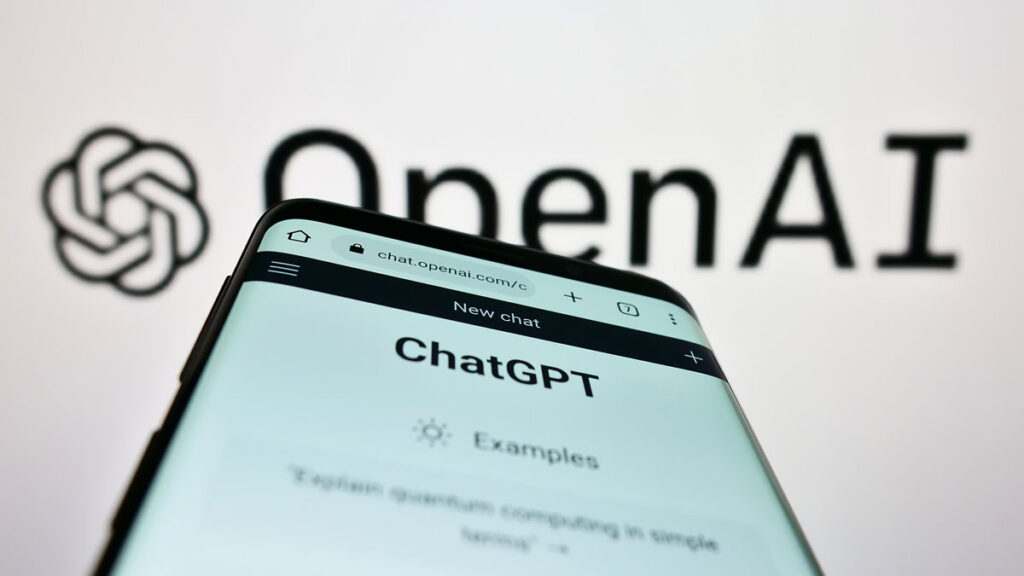
What ChatGPT has achieved is to bring Artificial Intelligence closer to almost the entire society. Although AI has been in development for some time now, it is thanks to ChatGPT that everyone has realized what the use of artificial intelligence technologies can mean. The application in industrial robotics of Artificial Intelligence applications such as ChatGPT promise to transform automation and industrial robotics for good. One of the areas in which technologies such as ChatGPT may have more applications is industrial robotics. As we know ChatGPT, it does not seem to make much sense to implement it in automation and industrial robotics environments. Nothing could be further from the truth. To find out how the use of ChatGTP can affect industrial robots, and without analyzing the section on ethics in the application of artificial intelligence, the first thing to do is to know what the popular application consists of. In reality, we are talking about an artificial intelligence chatbot. Its quality is that it has been trained to hold conversations with any person thanks to the fact that the algorithms with which it has been developed are capable of understanding any question asked by the user; in other words, it has Natural Language Processing (NLP) capabilities. This was already done in a limited way by many chatbots programmed for this purpose, and therefore, the change that this implies ChatGPT is that it is able to respond as if it were a human and, moreover, with accurate data and information on any subject, making it almost impossible to distinguish whether the response comes from a human being or an artificial intelligence. How does ChatGPT fit into an industrial robot? Being therefore a language-centric artificial intelligence it seems a more specific application in dealing with users and, by extension, for example, in customer services through Cognitive Virtual Assistants (CVA). It is more difficult to understand what such technology can bring to an industrial robot, but developments are already beginning to be made so that they can interact naturally with human workers. The goal of the developments that are beginning to be studied is that ChatGPT can go a step beyond analyzing text and providing answers and obtain data that it can process and analyze to assist in automation and industrial robotics tasks. The ultimate goal is to enable robots – such as autonomous mobile robots or AMRs – to «talk» to humans without having to learn programming languages. The use of AI in industrial robotics aggity’s solutions already incorporate artificial intelligence, which makes it possible for machines to interact through voice and natural language processing. In this way, machines can now interact with people without us even realizing it, offering a better and higher quality service, especially in repetitive and low-value actions. The development of hyper-automation will take a step forward thanks to the use of technologies such as ChatGPT. By being able to interact with humans more effectively, industrial robotics will further contribute to cost efficiency as well as improved production times, as is already the case in many different sectors of activity. For example, artificial intelligence is already an ally of the pharmaceutical industry. If the use of robotic process automation (RPA) technologies reduces human intervention and automates certain tasks, the incorporation of technologies such as ChatGPT will also contribute to an evolution in the way more physical tasks are performed. What’s new in ChatGPT The novelty brought by ChatGPT is that it can execute tasks on its own thanks to prior learning, a capability that will make it possible to carry out certain actions or solve certain problems within a smart factory without the need for human intervention, which is still required in many cases. Among the possible uses of this technology, and this is where research is being carried out, is the application of ChatGPT to monitor the performance of industrial robots, observe different scenarios and make decisions based on data without the intervention of any worker. At the moment, the main and first uses of ChatGPT in industrial robotics (ChatGPT for Robotics) have to do with drone control or manipulation of robotic arms. We are, therefore, facing a new step in the evolution of artificial intelligence that opens up new possibilities for its contribution to the evolution and expansion of industrial robotics.
MES systems: a global monitoring of Industry 4.0
MES systems automatically monitor, store and trace all activity performed by factory operators, providing detailed information about WHO did the activity, WHAT they did, WHERE it took place and WHEN it was performed. The Haystack Syndrome Maria, the production manager, and Juan, the factory manager, do not have an overview of what is going on «downstairs» for some time, and up-to-date information is conspicuous by its absence. They do not know the detailed status of the progress of the production plan at all times, so it is impossible for them to answer questions to the sales team such as: «Customer ABC is asking me if order 123456 will be delivered on the 3rd of next month, as agreed». The absence of truly reliable information on the time spent on product and format changeovers, cleaning, micro-stops and losses due to low machine speed prevents the implementation of continuous improvement policies. Other factory or production managers do have information, but they have it in very inflexible Excel formats for analysis and, above all, it is not available to be shared with the team at any time. Juan and Maria have realized that they have thousands of data, but when it comes down to it, they cannot find the information that is really relevant for decision making, which prevents them from knowing exactly what is really going on in the factory. They don’t know it, but they suffer from the so-called «haystack syndrome». Having millions of DATA is NOT RELEVANT INFORMATION. Maria often discovers that a level of product rejection is occurring, which is out of control due to a lack of real-time information. When this happens, it is too late, the product is not usable. In trying to organize improvement actions, Maria realizes that, lacking reliable information, she has not asked the operators about their problems, nor has she given them feedback on how things are going. In short, it has not involved them in the detection and solution of problems… it is a fish that bites its own tail. MES systems or software: What are they and what do they do? A smart factory or factory 4.0 has a system that captures data from production and other manufacturing areas such as maintenance, quality, logistics and planning, crosses them and generates relevant information that helps to make decisions in the short, medium and long term, and with a multidisciplinary vision (a factory is not only production). These systems are known as MES systems or Software MES (Manufacturing Execution System). From a strictly production point of view, every MES system: Collects data automatically. Details machine stoppages and reasons for rejected product. Allows paperless management of the entire factory. It shows the realized and pending production in real time, allowing to know how is the production plan at any time and from any place. Analyzes productivity and resource efficiency. Provides reports for short-, medium- and long-term production management. Plots direct and indirect activities, justified machine stoppages, preparations, quantities produced, rejects according to type, rework. Monitor resources and consumption in real time. It has real-time dashboards (operator, machine, OF…). Enables workload histograms for each machine. Generates interactive maps of factory, department, area or work center, showing the status of the machines at all times. MES systems automatically monitor, store and trace all activity performed by factory operators, providing detailed information about WHO did the activity, WHAT they did, WHERE it took place and WHEN it was performed. INDUSTRY 4.0 is synonymous with INTERCONNECTIVITY between machines, things, people, systems, processes, and other actors such as customers, suppliers or other types of collaborators. MES solutions are at the heart of all connectivity if the production process is to be oriented towards the smart factory, and are the management solution par excellence for shift managers, area managers, factory managers and industrial managers. Written by David Fernández Industry Area Manager at aggity
Industry 4.0: robots, sensors or augmented reality, this is what smart factories look like
Intelligent robots that work in a friendly way with operators, multisensors for machines to communicate, augmented reality to visualize prototypes, that and more is what is called the revolution of industry 4.0 or the smart factories and where the Spanish sector seeks to embark. where the Spanish sector is looking to embark. Factory 4.0, the IoT environment and Big Data. The Internet of Things and the Big Data, which relates data to human activities, has the ability to revolutionize traditional processes with the right tools. In order to adapt to user demand, the new 4.0 factories are increasingly demanding «à la carte» products designed by themselves and that are fast at home. According to experts, factories must be prepared to guarantee an individualized offer in real time. Companies like Nike already allow individualized design of sneakers: choose textures, fabrics, colors. In addition, manufacturers of food products such as muesli are giving the option to customize cereals in various aspects such as quantities, added ingredients or type of packaging. The economic potential of the Internet of Things for businesses and governments is enormous; according to Cisco, up to 14.5 trillion euros could be «in play» by 2023. Learning machines Among the characteristics of this new type of industry is collaborative robotics, with which the machines help the operator in repetitive or dangerous tasks without attacking him by recognizing him and with which they can already share activities in the same physical location. Or, cyber-physical systems, where tiny computers proliferate with systems included in the manufacturing and enormous functionalities for information processing. Likewise, sensorization, intelligent vision and augmented reality, with machines that learn by themselves under the tutelage of the operator, who is a key player in this manufacturing process, and to whom they offer assistance with interactive glasses. Additive or layered manufacturing is also essential in this new industry as it saves time and money compared to traditional techniques such as prototyping from molds, which are very costly when orders are small. «They want to bring the factory back to Europe while in the past it was offshored in search of cheap labor and that also caused talent to flee,» explained Loreto Susperregi. In this incipient industrial 4.0 race, Spain is in a good position, «on the starting grid,» according to David Sánchez. «We cannot let this opportunity pass us by,» because so far, «no country has taken the lead,» he added. The time to «get on the revolution». Leading countries in this industry are Germany and the United States. At this moment the Spanish industry «has the option of joining this revolution», and if it does not do so, it will lose competitiveness. The U.S. is also making steady progress in this type of factory. Recently, in Chicago, industry leaders met at the Forum for the Internet of Things to drive this industrial model within the framework of a forecast deficit of two million professionals with expertise in this new world. Reuse of information Technology companies and universities are mobilizing to adjust training profiles to the new needs. One of the members of its advisory board, Jorge Calderón, has detailed in-demand professions such as data engineers capable of reusing huge amounts of information, cybersecurity professionals and experts in designing simpler and more convenient interfaces. In this new production framework, Opera MES has created a cloud technology that interconnects devices and is very useful for industries such as pharmaceuticals, whose products require specific temperature ranges throughout the distribution chain, among many other sectors that may benefit. It is also integrated with the Social Business platform, to bring mobile and agile communication to operators at the right time and in real time.
Social MES ensures connection and intercommunication of everything to everything
OBSOLETE MACHINERY AND CONTROL SYSTEMS Other conclusions have more to do with the ability to solve certain problems. Thus, 52% of these industries do not know how to reduce raw material wastage or overfilling. 67% of factories are producing between 4% and 8% too much to meet their demand, well above an adequate tolerance margin (between 1% and 3%). These data reveal a problem of obsolescence, both in terms of machinery and control and measurement procedures. But to face it, a recurrent starting point is assumed since the first Industrial Revolution: investment in new production equipment. This erroneous vision is complicated by the range of existing technologies and solutions to undertake this process of reconversion: advanced robotics, cybernetic systems, artificial intelligence, 3D printing and IoT, among others, seem to embody the benefits of this fourth Industrial Revolution. However, this vision hides other simpler, lower cost and more effective solutions to improve any production process. For example, an automatic data capture system or, going one step further, an MES solution reduces the time to take corrective action in the event of a production problem and results in a 30% reduction in related costs. 52% do not know how to reduce raw material wastage or overfilling SOCIAL MONTH FOR REAL PROBLEMS We are not talking about miracles or magic tricks, but about the application of digital solutions that have been developed exclusively for manufacturing environments and that have proven their usefulness in a significant number of facilities around the world. These MES solutions allow, in a first step, to increase the productivity of the factory in ratios between 30% and 35%, only with the automation of data capture in a reliable way and in real time. In addition, they also manage to involve and integrate all departments – planning, production, quality, maintenance, logistics… – becoming the true heart of the «smart» factory, in which to support the continuous process of digital transformation that will make the existence of an industry 4.0 feasible. To achieve this, we, the MES solution providers, have taken it upon ourselves to make them ready and prepared for the new Industry 4.0 environment, intermediate step in the development of a true smart factory, in which plant automation must be done in parallel to its connection with the supply chain, distribution centers and all business management systems. At this point, there are three nuances: capturing data, even digitally from machines, is not an MES system; having a large volume of data does not mean having relevant information; and, finally, an MES solution also falls short for the new Industry 4.0 context. On new technologies based on IoT contributions, big data, artificial intelligence, virtual and augmented reality, and the like, a process of interconnection has to take place that must encompass machines, devices, systems, people and all the economic actors with which our factory is related, from raw material suppliers to the distribution channel, including customers and partners. This is what we call Social MES, a system that ensures the connection and intercommunication of everything with everything, in which we apply, in addition to the logic of traditional MES systems, an extra layer based on a new generation of applications of social business for collaborative management based on social networks, machines connected to corporate networks and interacting with each other, apps and web applications and mobile devices of all kinds. This ensures a production environment in which information flows in order to be more efficient and effective, to produce more and better, and with adjusted costs. With the data we have on real applications, we can speak of spectacular results in FMCG factories where we have managed to increase productivity by 30%, eliminate downtime by 75%, reduce paper use by 90% and improve production quality by 20%. This whole process of digital transformation of the industry can be very simple. The idea is to take advantage of the knowledge and use that end users make of all kinds of communication, collaboration and social networking tools, and transfer it to a secure and confidential environment within the company. In parallel, you must be able to combine and connect them with traditional transactional and management systems (ERP, CRM, CMS), mobility technologies, intelligent information analysis, IoT, robotics and artificial intelligence. Factory 4.0 must be not only smart, but also social. Author: Oscar Pierre – President and CEO aggity Interview for digitalbizmagazine
The use of business chat substantially improves corporate image
Among the technologies to be used by the company, one of the strong points is all technology related to information and communication. And within it, corporate instant messaging or corporate chat is one of the tools that can bring great benefits to companies. A instant messaging software for companies such as Corporate Messenger is a form of real-time communication that allows us to maintain instant communication with our interlocutor, as its name suggests, being able to send and receive short messages between one or several interlocutors. Normally the instant messaging service is offered in a pop-up window on our web page where we can write in plain text and even add emoticons. The messages we write are received in real time and the recipient can answer us immediately having a written conversation very similar to a telephone conversation. Some instant messaging servers also allow sending files or messages to a user even if he/she is not connected at that moment. This software is always active as long as there is an Internet connection. To get it up and running you need software provided by the Instant Messaging Network providers. You can request your FREE demo here. More and more companies, both large and small, are making use of this tool encompassed in ICT technologies. Instant messaging is the text version of telephone conversations. To make use of this fantastic ICT tool, it must have a minimum quality support, have a protocol for its use and travel encrypted conversations. At the same time, it must be perfectly integrated with the rest of the applications used by the company in its communication with all the actors with which it relates, such as e-mail and web pages. The availability of a corporate instant messaging software helps us to: Significantly reduce communication costs. It is an excellent communication channel both internally and externally. It solves communication problems with customers or between departments of the same company more efficiently than e-mail. Allows you to be performing another task at the same time. It favors us over our competitors by providing us with more means with which to facilitate communication with our interlocutors in an exponential way. Using a Corporate Instant Messaging application helps us to consolidate our position as a reference company in our sector by further facilitating communication with our customers, suppliers and, in general, with all the agents with whom we interact commercially. In addition, it allows us to save costs and, consequently, to increase profits and, finally, it improves our image as an innovative company.
